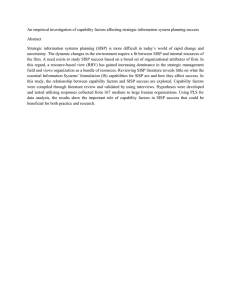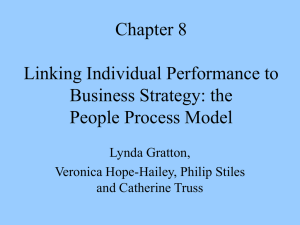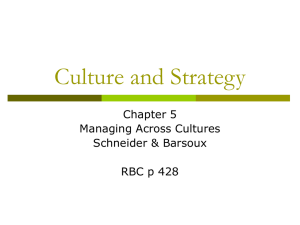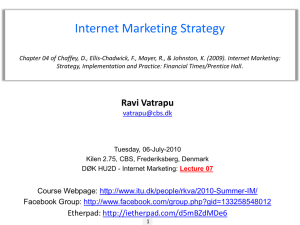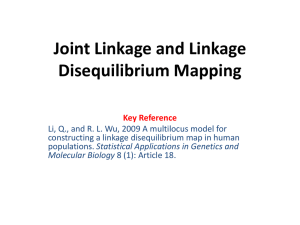SISPToolsv2
advertisement
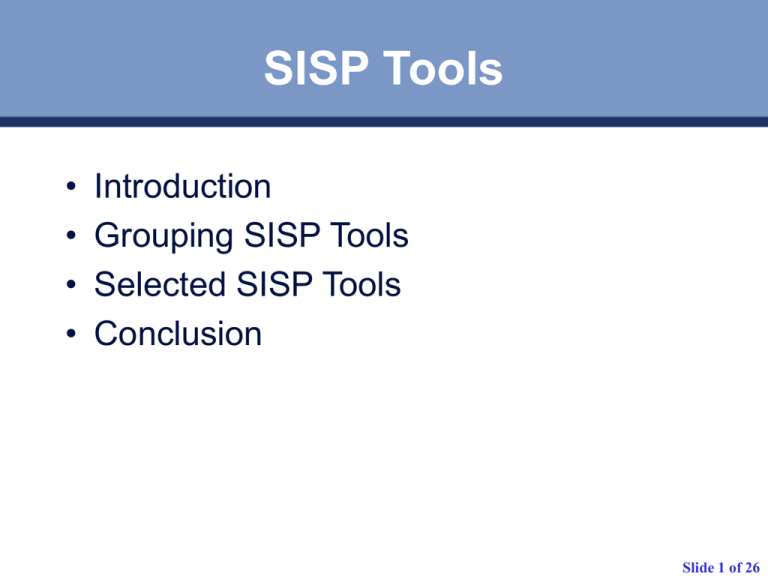
SISP Tools • • • • Introduction Grouping SISP Tools Selected SISP Tools Conclusion Slide 1 of 26 Introduction • Over the years a number of tools have been developed to assist with the IS strategy planning process • Some organisations use 1 or 2 models only, others use a number of tools to deal with different aspects of IS planning Slide 2 of 26 SISP Tools (Some Examples) • Checklists – – • Opportunity Search Strategic Analysis Internal Position – – – – Analysis of the internal position • Generic IS Strategies • Value Chain Analysis Evolutionary Models • E.g. Stages of Growth Model Information Requirements Analysis • E.g. CSF Analysis Portfolio Management Approach • E.g. Internet Value Matrix External Position – Analysis of Competitive Position e.g. • Five forces model • Generic Strategies • Strategic Thrusts Business Analysis e.g. Swot, PLEETS Sector Analysis Business Opportunities – – • • • Linkage/Future Models – Linkage Models • E.g Linkage Analysis Planning – Future Models • E.g. Scenario planning Slide 3 of 26 SISP TOOLS Analysed Further (10) – Checklists • SWOT – Business Opportunities • Strategic Analysis Matrix – Analysis of the Internal Position • • • • Value Chain Analysis Stages of Growth Model CSF Analysis Internet Value Matrix – Analysis of Competitive Position • Competitive Five Forces Model • Generic Business Strategies – Linkage/Future Models • Linkage Analysis Planning • Scenario Planning Slide 4 of 26 CHECKLISTS Slide 5 of 26 Situation IS Faces SWOT Analysis Opportunity Threat Attack Beware Explore Play Safe Strength Weakness Evaluation of IS Capability Slide 6 of 26 BUSINESS OPPORTUNITIES Slide 7 of 26 Strategic “IS Portfolio” Analysis(1996) Ward and Griffiths (1996) (Market Growth) Star (Invest) Wild cat (Examine) Turnaround Strategic competitive Dog (Divest) importance Support of planned IS Strategic importance advice Cash Cow (Milk) Factory Strategic competitive importance of current IS (Market Share) BCG Matrix Robson ch 2 page 53, McFarlan & McKenney (1983) IS Strategic Grid Slide 8 of 26 ANALYSIS OF THE INTERNAL POSITION Slide 9 of 26 Firm’s Value Chain Analysis (1985) Firm Value Chain Analysis ... Slide 10 of 26 Stages of Growth Model (Nolan, 1974) Stages of Growth Model …. STAGES OF GROWTH (Nolan) Learning Cost Initiation cost reduction Contagion Control Maturity “hold” new database+ functions telecomms+ end user computing time Slide 11 of 26 Stages of Growth Model contin.. Stages of Growth Model …. • Expenditure on IT/ IS followed an S-curve over time • Organisational learning also followed an Scurve • Each stage marks a new approach to managing and using IT/IS • Movement between stage often prompted by an organisational crisis in the life of the IT function Slide 12 of 26 Critical Success Factors (Rockart,1977) • Identify Critical Success Factors • Identify Key Decisions related to the CSFs • Identify the Information Required to support those decisions Slide 13 of 26 CSF Analysis • Successful application requires skilled team • Attractive to top management teams • Managers not experienced in strategic planning may find it difficult • Incorporated into a number of methodologies e.g. Andersen Consulting’s Method/1 Slide 14 of 26 Internet Value Matrix( Alexander, 2000) Criticality to Business New fundamentals Operational Excellence Newness of Idea Low Low High Low Rational experimentation Low High Breakthrough Strategy High High Slide 15 of 26 Internet Value Matrix contin.. • This is a Portfolio planning technique used by Cisco to ensure it develops a well-rounded Portfolio of IT projects • Today, Cisco’s portfolio revolves around the internet Slide 16 of 26 ANALYSIS OF COMPETITIVE POSITION (EXTERNAL) Slide 17 of 26 Porter’s Competitive 5 Forces Model (1985) Porters 5 Forces ... Can IS Change the balance of power with suppliers? Can IS Build barriers to entry? Can IS change the basis of competition ? Can IS build in switching costs? Can IS generate new products or services? Robson, ch 5, pg 128 Porter’s five forces Slide 18 of 26 Generic Business Strategies (Porter, 1985) • Low Cost – Reduce overall costs in production and operations • At point of sale • Differentiation – Add features to the product or service directly • Focus/niche – Identify and create market niches directly Slide 19 of 26 Strategic Thrusts (Rackoff, 1985) • Strategic Thrusts ….. • Extends Porters Generic strategies into five: – Low Cost – Differentiation – Innovation – Growth – Alliance • These are targeted at – Suppliers – Customers – Competitors Slide 20 of 26 Strategic Options Generator Strategic Options Generator ... What is the strategic Target? Supplier Customer Competitor What is the strategic Thrust? Differentiation Low Cost Innovation Growth Alliance What is the Mode? Offensive Use Defensive What is the Direction? Provide Slide 21 of 26 LINKAGE/FUTURE MODELS Slide 22 of 26 Linkage Models (Primozic, 1991) • Examines links organisations have with one another • Goal – create a strategy utilising electronic channels Step 1: Define power relationships among the various players and stakeholders Step 2: Map out the extended enterprise to include suppliers, buyers and strategic partners Step 3: Plan electronic channels to deliver the information component of products and services Slide 23 of 26 Scenario Planning (Schwartz, 1991) • SCENARIOS – stories about the way the world might be in the future • The goal is not to predict the future • Explore forces that may cause different futures to take place • Decide on actions if forces materialise • Case Example – Scenarios on the Future of IS Management Slide 24 of 26 Scenario Planning contin.. Step 1: Define a decision problem and timeframe to bound the analysis Step 2: Identify major known trends that will affect the decision problem Step 3: Identify just a few driving uncertainties Step 4: Construct the scenarios Slide 25 of 26
